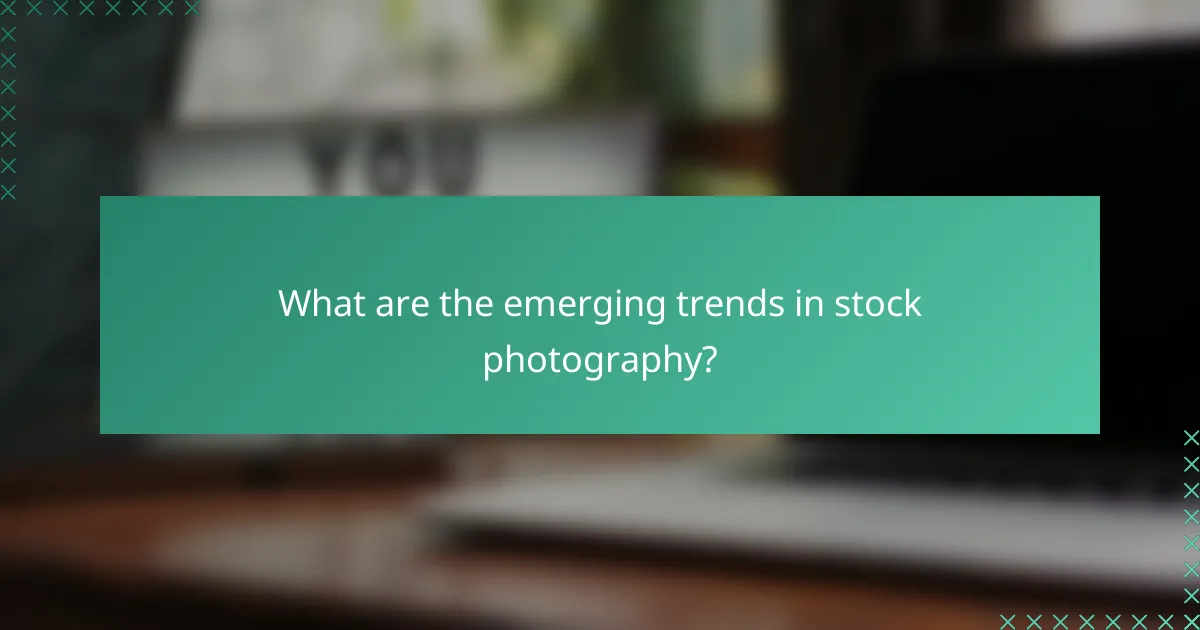Stock photos play a crucial role in the visual content landscape, with quality standards that include resolution, licensing, and technical specifications. Pricing models for these images vary significantly, ranging from free options to premium offerings, depending on quality and usage rights. The primary audience for stock photos consists of professionals and businesses seeking affordable and diverse imagery to elevate their marketing and creative projects.

What are the quality standards for stock photos?
Quality standards for stock photos encompass several key factors, including resolution, licensing, relevance, technical specifications, and necessary releases. Adhering to these standards ensures that images meet the needs of buyers and can be used effectively across various platforms.
Resolution and clarity
Resolution and clarity are critical for stock photos, as they determine how images appear in different formats. High-resolution images, typically at least 300 DPI (dots per inch), are preferred for print, while 72 DPI is generally sufficient for web use. Clear, sharp images enhance visual appeal and usability.
When selecting stock photos, consider the intended use. For large prints or detailed designs, opt for images with higher resolutions, while lower resolutions may suffice for social media or small web graphics.
Licensing and usage rights
Licensing and usage rights dictate how stock photos can be utilized. Most stock images come with either royalty-free or rights-managed licenses. Royalty-free allows for broader use without additional fees, whereas rights-managed licenses restrict usage based on specific terms.
Always check the licensing agreement before purchasing or downloading stock photos. This ensures compliance with usage restrictions and helps avoid potential legal issues.
Content relevance and composition
Content relevance and composition are essential for stock photos to effectively convey the intended message. Images should align with the theme or subject matter of the project, ensuring they resonate with the target audience.
Good composition involves balancing elements within the frame, using the rule of thirds, and maintaining visual interest. Consider how the image will fit into your overall design or marketing strategy.
Technical specifications
Technical specifications include file formats, color profiles, and dimensions. Common file formats for stock photos are JPEG and PNG, with JPEG being suitable for most applications due to its balance of quality and file size.
Ensure that the color profile matches the intended output, such as RGB for digital use and CMYK for print. Understanding these specifications helps in selecting the right images for your needs.
Branding and model releases
Branding and model releases are important when using stock photos featuring identifiable people or trademarks. A model release is a legal document granting permission to use a person’s likeness, while a property release is needed for recognizable private properties.
When purchasing stock images, verify that necessary releases are included or available. This protects against legal issues and ensures that the images can be used freely in commercial contexts.

How much do stock photos cost?
The cost of stock photos varies widely based on the pricing model, quality, and licensing options. Generally, prices can range from free to several hundred dollars, depending on the source and intended use.
Subscription pricing models
Subscription pricing models allow users to pay a recurring fee for access to a library of stock photos. These plans typically offer a set number of downloads per month or unlimited access for a higher fee, making them cost-effective for businesses that require frequent image use.
For example, a monthly subscription might cost between $30 and $200, depending on the provider and the number of images included. This model is ideal for marketers and content creators who need a steady stream of fresh visuals.
Pay-per-download pricing
Pay-per-download pricing charges users for each individual stock photo they download. This model is straightforward and suitable for those who need images infrequently or for specific projects.
Prices for pay-per-download can range from a few dollars to over $50 per image, depending on the resolution and licensing terms. Users should carefully review the licensing agreements to ensure the images meet their usage requirements.
Free stock photo options
Free stock photo options are available through various websites that offer images at no cost. These photos can be used for personal or commercial purposes, but users must check the licensing terms to ensure compliance.
Popular platforms like Unsplash and Pexels provide high-quality images for free, but the selection may be limited compared to paid services. Always credit the photographer when required to support their work.
Bulk purchase discounts
Bulk purchase discounts are offered by many stock photo agencies for customers who buy a large number of images at once. This pricing strategy can significantly reduce the cost per image, making it an attractive option for businesses with extensive visual needs.
Discounts can vary, with some agencies offering 20-50% off when purchasing packages of multiple images. It’s beneficial to compare different agencies to find the best deal that aligns with your requirements.

Who is the target audience for stock photos?
The target audience for stock photos includes various professionals and businesses that require high-quality images for their projects. These users typically seek affordable, diverse, and easily accessible visual content to enhance their marketing, branding, and creative efforts.
Marketing professionals
Marketing professionals rely heavily on stock photos to create engaging campaigns and promotional materials. They often look for images that resonate with their target demographics, ensuring that visuals align with brand messaging. Stock photos can save time and budget compared to custom photography, making them a practical choice for campaigns.
When selecting stock photos, marketers should consider the emotional impact of images and their relevance to the campaign’s objectives. Using images that evoke the right feelings can significantly enhance audience engagement and conversion rates.
Content creators and bloggers
Content creators and bloggers use stock photos to enrich their articles, social media posts, and websites. High-quality visuals can help attract readers and keep them engaged, making it essential to choose images that complement the written content. Stock photos provide a cost-effective solution for creators who may not have the resources for professional photography.
To maximize the effectiveness of stock photos, content creators should ensure that the images are relevant to their topics and maintain a consistent style across their platforms. This helps establish a recognizable brand identity and enhances overall content quality.
Small business owners
Small business owners often utilize stock photos for marketing materials, websites, and social media. These images can help convey professionalism and attract customers without the high costs associated with hiring photographers. Stock photos are particularly useful for businesses with limited budgets and resources.
When choosing stock photos, small business owners should focus on images that reflect their brand values and target audience. It’s also advisable to consider licensing options to ensure proper usage and avoid potential legal issues.
Designers and agencies
Designers and agencies frequently incorporate stock photos into their projects, including advertisements, websites, and presentations. These images can serve as a foundation for creative work, allowing designers to build visually appealing layouts efficiently. Stock photos can also provide inspiration for new design concepts.
Designers should be mindful of the licensing agreements associated with stock photos, as these can vary significantly. Understanding the terms of use is crucial to avoid copyright infringement and ensure that the images can be used as intended in client projects.

What criteria should be used to select stock photos?
Selecting stock photos involves evaluating several key criteria to ensure they meet your project’s needs. Focus on image quality, relevance to your content, and the licensing terms associated with each photo.
Image quality and resolution
Image quality is critical for maintaining a professional appearance in your projects. Look for high-resolution images, typically starting at 300 DPI for print and 72 DPI for web use, to ensure clarity and detail. Avoid low-quality images that may appear pixelated or blurry when scaled.
Consider the format as well; JPEGs are common for photographs, while PNGs are preferred for images requiring transparency. Always check the specifications provided by the stock photo service to ensure compatibility with your intended use.
Relevance to project needs
The relevance of stock photos to your project is essential for effective communication. Choose images that align closely with your content’s theme, message, and target audience. For instance, a corporate presentation may require images of professionals in a business setting, while a travel blog might benefit from scenic landscapes.
Utilize keywords and filters on stock photo platforms to narrow down your options. This approach helps you find images that not only fit your aesthetic but also resonate with your audience’s interests and expectations.
Licensing terms
Understanding licensing terms is crucial to avoid legal issues when using stock photos. Stock images typically come with different licenses, such as royalty-free or rights-managed. Royalty-free images allow for broader use without additional fees, while rights-managed images may have restrictions based on usage type and duration.
Always read the licensing agreement carefully to ensure compliance with usage rights. Some licenses may require attribution or limit the number of copies you can distribute. Familiarizing yourself with these terms can save you from potential legal complications down the line.

What are the emerging trends in stock photography?
Emerging trends in stock photography reflect the evolving needs of consumers and technological advancements. Key trends include the rise of authentic imagery, increased demand for diverse representation, and the integration of AI-generated content.
Quality Standards
Quality standards in stock photography are crucial for ensuring that images meet the expectations of buyers. High-resolution images, proper lighting, and professional composition are essential. Additionally, images should be free from noise and have accurate colors to maintain visual appeal.
Many platforms require contributors to adhere to specific guidelines, which may include technical specifications like minimum pixel dimensions and file formats. Always check the requirements of the stock photo site you are using to ensure compliance.
Pricing Models
Pricing models for stock photography vary widely, often based on licensing types and image usage. Common models include subscription plans, pay-per-download, and credit systems. Subscription plans typically offer a set number of downloads per month for a flat fee, while pay-per-download charges users for each image they purchase.
Prices can range from a few dollars for lower-quality images to hundreds for exclusive or high-resolution content. Understanding your target audience and their budget can help you choose the right pricing strategy.
Target Audience
The target audience for stock photography includes businesses, marketers, bloggers, and content creators seeking high-quality visuals. Each segment has distinct needs; for instance, marketers may prioritize images that convey brand identity, while bloggers might look for relatable and authentic visuals.
Identifying your audience’s preferences can guide your content creation. For example, businesses may prefer images that reflect diversity and inclusivity, while social media influencers might seek trendy and eye-catching visuals. Tailoring your offerings to these needs can enhance engagement and sales.
